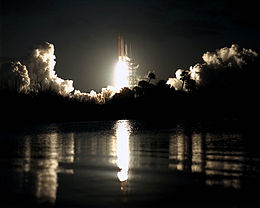STS-61-C

The launch of Space Shuttle Columbia on the STS-61-C mission, 12 January 1986.
|
|
| Mission type | Satellite deployment Microgravity research |
|---|---|
| Operator | NASA |
| COSPAR ID | 1986-003A |
| SATCAT no. | 16481 |
| Mission duration | 6 days, 2 hours, 3 minutes, 51 seconds |
| Distance travelled | 4,069,481 kilometers (2,528,658 mi) |
| Orbits completed | 98 |
| Spacecraft properties | |
| Spacecraft | Space Shuttle Columbia |
| Launch mass | 116,121 kilograms (256,003 lb) |
| Landing mass | 95,325 kilograms (210,156 lb) |
| Payload mass | 14,724 kilograms (32,461 lb) |
| Crew | |
| Crew size | 7 |
| Members |
Robert L. Gibson Charles F. Bolden George D. Nelson Steven A. Hawley Franklin R. Chang-Diaz Clarence W. "Bill" Nelson Robert J. Cenker |
| Start of mission | |
| Launch date | 12 January 1986, 11:55:00 UTC |
| Launch site | Kennedy LC-39A |
| End of mission | |
| Landing date | 18 January 1986, 13:58:51 UTC |
| Landing site | Edwards |
| Orbital parameters | |
| Reference system | Geocentric |
| Regime | Low Earth |
| Perigee | 331 kilometres (206 mi) |
| Apogee | 338 kilometres (210 mi) |
| Inclination | 28.5 degrees |
| Period | 91.2 min |
 Back row L–R: Bill Nelson, Hawley, George Nelson, Front row L–R: Cenker, Bolden, Gibson, Chang-Diaz |
|
STS-61-C was the twenty-fourth mission of NASA's Space Shuttle program, and the seventh mission of Space Shuttle Columbia. It was the first time that Columbia, the first operational orbiter to be constructed, had flown since STS-9. The mission launched from Florida's Kennedy Space Center on 12 January 1986, and landed six days later on 18 January. STS-61-C's seven-person crew included the second African-American shuttle pilot, future NASA Administrator Charles Bolden, the first Costa Rican-born astronaut, Franklin Chang-Diaz, and the second sitting politician to fly in space, Representative |Bill Nelson (D-FL). It was the last shuttle mission before the Space Shuttle Challenger disaster, which occurred just ten days after STS-61-C's landing.
STS-61-C saw Columbia return to flight for the first time since the STS-9 mission in November 1983, after having undergone major modifications over the course of 18 months by Rockwell International in California. Most notable of these modifications was the addition of the SILTS (Shuttle Infrared Leeside Temperature Sensing) pod atop Columbia's vertical stabilizer, which used an infrared camera to observe reentry heating on the shuttle's left wing and part of its fuselage. The camera was only used for a few more missions after STS-61-C, but the pod remained on Columbia for the remainder of its operational life. Smaller and more discreet modifications were also added at various points throughout the shuttle. The bulky ejection seats, which had been safed after STS-4, were replaced with conventional seats and head-up displays for the commander and pilot were installed.
...
Wikipedia

